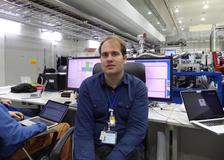Thomas A. White at an experiment at the Japanese X-ray laser SACLA. (Credit: Rie Tanaka, RIKEN)
For his outstanding contribution to the analysis of biomolecules with X-ray lasers, DESY scientist Thomas A. White has been awarded the Max von Laue Prize by the German Crystallographic Society. With the award, the prize committee is recognising White's unique software suite CrystFEL, without which the analysis of numerous ground-breaking experiments would not have been possible.
So-called X-ray free-electron lasers (XFELs) produce extremely short and brilliant flashes of laser-like X-ray light, allowing materials to be studied on an atomic scale and molecular dynamics to be captured in individual steps. X-ray lasers open up exciting new research avenues in the field of crystallography, the study of molecular and atomic crystal structures using X-rays.
When X-rays are incident on a crystal, they are diffracted by the crystal lattice in a characteristic way, as was demonstrated by the pioneer physicist Max von Laue in 1912. The resulting diffraction pattern can be used to calculate the internal structure of the crystal. Nowadays, scientists use this method to study numerous materials, from new compounds for photovoltaic cells through to proteins and other biomolecules.
Before such analyses can be carried out, the samples first need to be grown in the form of crystals. The diffraction pattern then reveals the spatial structure of the crystal, and hence that of its individual building blocks, such as the protein under investigation. However, particularly biomolecules are often difficult to crystallise and the resulting crystals are very small.
The bright pulses of X-ray light produced by free-electron lasers have made it possible to analyse such tiny crystals too. To do so, thousands of micro-crystals are fired through the pulsed beam of the X-ray laser. This so-called serial femtosecond crystallography (SFX) produces a correspondingly large number of diffraction images. CrystFEL is able to process this flood of data and thereby enables scientists to analyse their SFX experiments. The software package developed at DESY by White is now used by scientists all over the world.
The Max von Laue Prize has been awarded annually since 1996, and is conferred on promising young scientists for outstanding scientific achievements in the field of crystallography. It comes with 1500 euros in prize money.
Previous winners of the Max von Laue Prize:
http://dgk-home.de/intern/ehrenmitglieder-und-preistraeger/preistraeger-des-max-von-laue-preises/
Further infomation:
About CrystFEL
(from DESY News)







